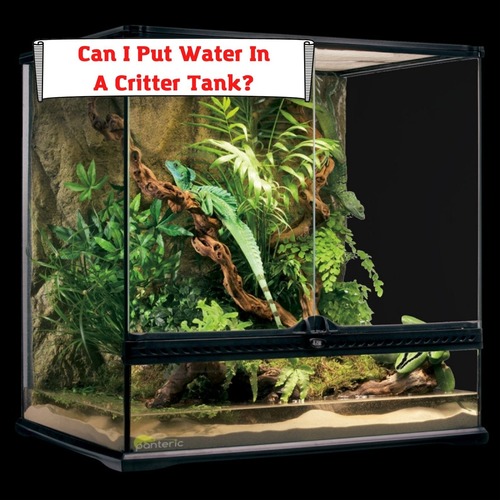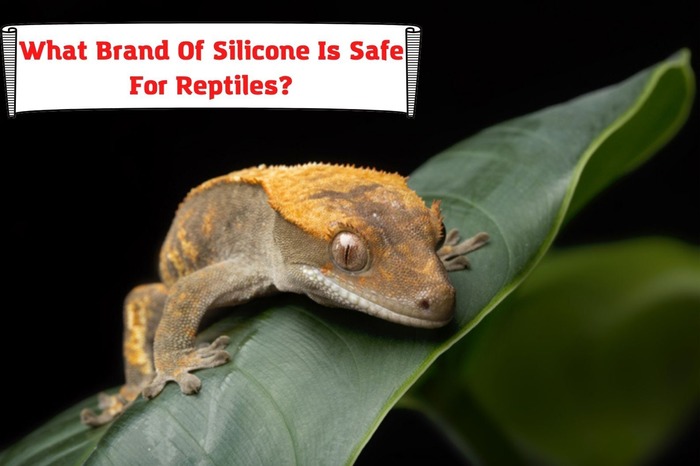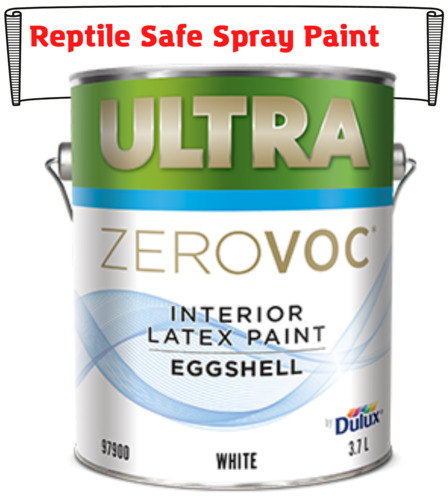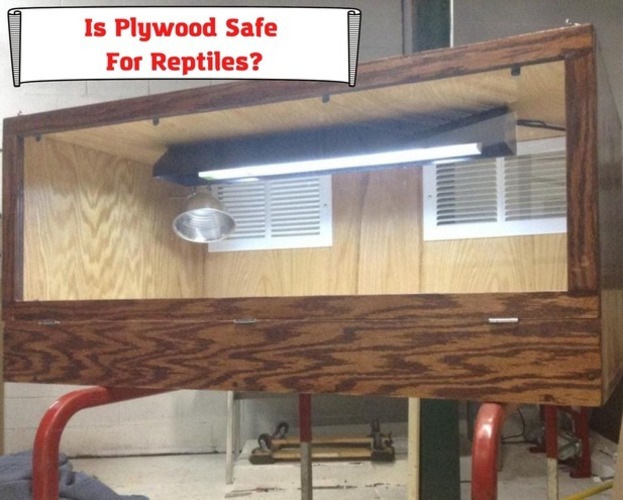Building an enclosure for your reptile is not the same as building a reptarium. Although both structures house the reptile, the reptarium is essentially a glass structure for displaying the reptile. But the enclosure is the shelter you provide your reptile for a fulfilling pet life.
Since the reptile is not for display but for company, many responsible pet owners often ask, “Is plywood safe for reptiles?”
This is a detailed discussion about the safety of using plywood for your reptile enclosure. It will help you make informed decisions as responsible pet owners.
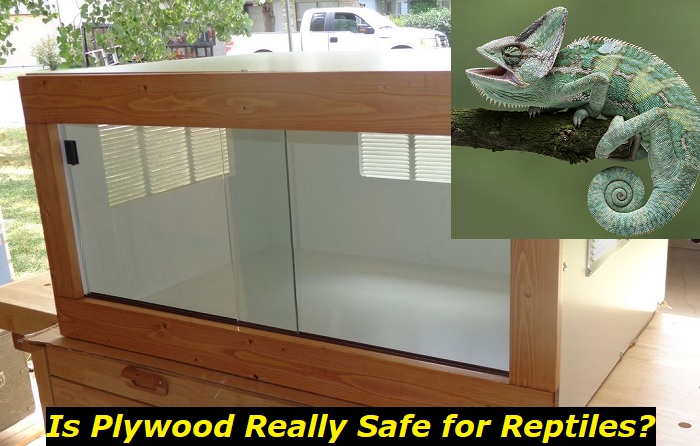
What Is Plywood?
Plywood is manufactured from natural wood. The manufacturers put together thin layers of wood and glue them together.
The product is bound firmly by passing it through a heating process under pressure. This creates a flat surface of wood known as plywood, which is not easily affected by diurnal temperature variations and seasons.
The inability of plywoods to expand or contract under hot or cold weather makes it a great choice for making pieces of furniture.
However, formaldehyde is the major chemical that serves as the binding agent of each layer of thin wood in plywood. The urea formaldehyde and phenol formaldehyde are the usual choices of many plywood manufacturers.
Both could cause harm to humans or reptiles if their fumes get inhaled at high levels.
Is Plywood Safe for Reptiles?
Many reptile enclosures are designed with plywoods because they are considered durable compared to natural woods.
However, the presence of formaldehyde in plywood makes it a concern for pet parents. Phenol formaldehyde emits lower levels of toxic fumes.
A greater percentage of these fumes get out within the first week of post-manufacturing, while what is left is at low levels and can be considered insignificant. Thus, making it less harmful to you and your crawling friends.
On the other hand, Urea-formaldehyde emits high levels of toxic fumes even after airing out for some weeks post-manufacturing.
This makes it a little bit of a threat to you and your pet. Research links this type of formaldehyde to some types of cancer. If your pet’s enclosure is constructed with plywood containing urea formaldehyde, you will want to ensure that the fumes don’t get to your reptile.
This is possible with the use of polyvinylidene chloride (PVC). Some owners of ball pythons mention that using PVC for building the inner walls, floor, and roof of their pet’s plywood enclosure keeps the formaldehyde from reaching them.
Others opined that acrylic paints were more helpful. They coated the entire inner space of the plywood to keep the toxic fumes from reaching their pets.
However, the paints also release toxic fumes. Although, when it is allowed to air out for a minimum of 48 hours, it becomes safe for your pet.
Other factors that affect the safety of plywood for your pet aside from its chemical components. These include:
- The strength of the plywood.
- The type of wood it is made from.
- Failure to seal the edges.
- Failure to make it waterproof.
- How well it cures before use.
- The choice of heating device used.
The stronger the plywood is, the safer it is for your reptiles. Enclosures made from plywoods that are not strong could collapse on your pet. This can cause them injuries or, worse – fatal.
The strength of plywood depends on the number of layers of thin wood it contains and the type of wood it is made from. Plywoods with thick widths are stronger than others with thin widths.
Also, plywoods made from hardwoods have more strength than those made from softwoods.
Formaldehyde isn’t the only fume from plywoods that could harm your reptiles. Fumes from aromatic woods such as cedar or rosewood could make your crawling pet sick.
So, it would be best to stick to plywood made from woods that do not give off scents like oak or birch woods for your pet’s safety as long as they have not been exposed to any chemicals.
What Can Happen If I use Plywood?
When you use plywood, there are a few risks you run. But with the right knowledge, right safety cautions, right building materials, and a good amount of research, you can avoid all these dangers.
The Risk of a Fire Injury
You need to provide a heat source for your pet in the enclosure; there are many ways to do this. Many reptile owners resort to using heat lamps, while others prefer heat mats.
The problem with the heat source is that it could lead to a fire in your pet’s enclosure if not properly fixed. You want to remember that plywood is wood, and wood is fuel for a fire. One of the most common ways this can happen is by using inferior electrical products. In many other instances, it is the failure to use the right wires for the job.
Using a weak wire where a more robust wire is required can lead to burns which could, in turn, lead to a bigger fire.
It is important to build the enclosure with the right items. You also want to avoid using highly flammable materials when building your enclosure. Although it is highly unlikely that a reptile owner will keep gas near the reptile enclosure, a relatable example is using paper as a substrate for your beardies in place of tiles.
While it is true that papers are easier to clean because you can just dispose of them and replace them, the chances of papers burning from contact with sparks from naked wires are way higher than the chances of tiles burning.
You also want to coat the enclosure with a fire-resistant sealant as this will minimize the chances of your enclosure easily flaming up in a possible fire outbreak as this will ensure that there is enough time for you to save your pet before the enclosure catches fire.
You also want to limit the chances of a fire breakout by using the heat source only as the manufacturer recommends. Fire outbreaks with heat mats are not uncommon, and the main reason is improper handling or using broken heat mats.
It would be best not to be bound by budget constraints when using a heat mat. If you have to buy a new one to replace the broken heat mat, it would be best to do just so.
The Risk of Injuries
Reptiles usually crawl, whether they have legs or not. A plywood enclosure with surfaces that have not been smoothened is not finished. If this is the case with your plywood enclosure, you are putting your pet at risk of being injured by the rough surfaces.
You also want to ensure that the nails are not protruding into the enclosure. If possible, it would be best to use safer means of securing the wood together. Sanding the surface and coating it with a good wood finish is another way to ensure that the enclosure is safe for your pet.
A connecting pipe is often worked into it to allow easy in and outflow of water. However, the plywood edges have spaces that can allow fluids to pass through, which can cause the enclosure to deteriorate.
When this happens, it may collapse upon your pet and result in serious injury. It is therefore important to seal the edges of the plywood for your pet’s safety.
Silicone sealant can be used for this purpose. You can carefully apply the sealant across all edges of the cage, then smoothen it through with a plastic knife.
You want all sealant applied and the internal surface of the plywood to be even. Any sealant extending outwards will create a rough surface when it dries up, and this can injure your pet.
The Risk of Electrocution
You can end up with an electrocuted pet as a pet owner, even though plywood does not conduct electricity.
It is advised to place a barrier between the ceramic heat bulbs and the inside of the enclosure. If you make the expensive mistake of installing the heat emitter bulb inside the cage, you put your reptile at risk of electrocution.
Another fatal mistake would be to use a low-quality hanger to hold the heat emitter. It would be best to use a wire clamp to ensure that it does not come in contact with any wires close to the enclosure or the enclosure itself.
If you use a heat lamp, it is recommended to place it vertically to achieve your temperature gradient. Placing it horizontally under a flammable material is not ideal.
Also, if your reptile accidentally bites the wires, it could die from electrocution.
Bottom Line
Reptiles need warmth and adequate humidity for them to thrive. Plywood enclosures can be designed to offer these.
However, for the safety of your reptiles, it will be great to research the best type of heat device for plywood enclosures before making a buying decision.
You also want to use only quality building materials.
- Dubia Roach Egg Sack: How To Understand if It’s Healthy? - January 2, 2023
- How To Feed African Dwarf Frog While on Vacation? - December 26, 2022
- Baytril for Bearded Dragon: Here’s What You Should Know - December 19, 2022
